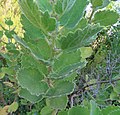| Tetradenia riparia | |
|---|---|
 | |
| Leaves and flowers | |
| Scientific classification | |
| Kingdom: | Plantae |
| Clade: | Tracheophytes |
| Clade: | Angiosperms |
| Clade: | Eudicots |
| Clade: | Asterids |
| Order: | Lamiales |
| Family: | Lamiaceae |
| Genus: | Tetradenia |
| Species: | T. riparia |
| Binomial name | |
| Tetradenia riparia | |
| Synonyms | |
Tetradenia riparia is a species of flowering plant native to southern Africa. It belongs in the mint and sage family Lamiaceae. [2] It is occasionally referred to as misty plume bush and is commonly used as a decorative garden plant due to its flowers when in full bloom. [3] Tetradenia means 'four glands' and riparia translates to 'growing on banks of rivers'. This species was first described by botanists Hochstetter and Codd in 1983. It is also known as ginger bush, incense bush, Ibozane and musk bush.









